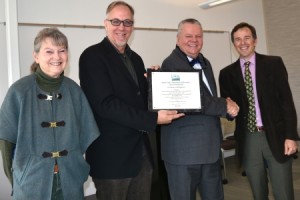(Originally posted on December 14, 2015)

Highlands representatives accept a USDA grant Dec. 10 to bring media arts degrees to Diné College. Attending the awarding ceremony were Linda LaGrange, associate vice president of academic affairs, Kerry Loewen, Media Arts and Technology Department chair, Sam Minner, president; and Terry Brunner, USDA state director of rural development for New Mexico. Photo: Margaret McKinney/Highlands University
Las Vegas, N.M – Navajo students at Diné College can earn media arts degrees from Highlands University thanks to a USDA grant to install state-of-the-art distance learning classrooms at the college.
The $438,715 grant from the USDA’s Rural Development program is funding the educational initiative through its Distance Learning Telemedicine Program.
“This funding will help pay for the technology to allow students on the Navajo Nation to access advanced classes offered by Highlands University hundreds of miles away,” said Terry Brunner, USDA state director of rural development for New Mexico. “Because of the partnership between Highlands and Diné, and with the USDA’s financial support, students on the Navajo Nation will have the opportunity to expand their education.”
Diné is a tribal college that serves the 26,000-square-mile Navajo Nation by offering primarily associate degrees and certificates. The Highlands media arts bachelor’s and master’s degree curriculum will be accessed at Diné’s main campus in Tsaile, Arizona as well as its five other sites in New Mexico and Arizona.
Sheila White, chair of Diné’s Arts and Humanities Department, said the partnership between Diné and Highlands media arts is exciting on many levels.
“This new program will give our Diné students the opportunity to earn a master’s degree for the first time in our college’s history,” White said. “These Highlands media arts degrees are in line with our college’s mission that focuses on culture, language and history. Our students will have the opportunity to preserve their own culture through filmmaking, digital photography, graphic design, video broadcasting, and other media.”
White said the partnership with Highlands will also greatly expand career opportunities for Diné College students.
Kerry Loewen, chair of the Highlands Media Arts and Technology Department, said: “This generous USDA grant will provide high-definition video connections from our new media arts Trolley Building that will open fall semester 2016. Multiple 85-inch screens, combined with the best audio available, will give the Diné students interactive access to the same classroom content our students experience.”
Loewen said the Diné classrooms are based on a model Yale University uses for telepresence, or video connections. He toured the Yale telepresence facilities two years ago to get ideas for the USDA grant proposal.
“With this USDA grant, the Navajo students at Diné will have easy access to state-of-the-art facilities that are nearly identical to Yale’s. Our sincere thanks to Terry Brunner and the USDA for providing this amazing opportunity for us to connect with a new generation of Navajo students,” Loewen said.
He said the USDA grant will also fund connecting Diné students to a Highlands classroom and laboratory at the New Mexico Museum of Natural History and Science in Albuquerque.
“This permanent classroom at the Museum of Natural History and Science is made possible through a ten-year partnership with the New Mexico Department of Cultural Affairs and our joint Program for Interactive Cultural Technology,” Loewen said.
Teresita Aguilar, provost and vice president for academic affairs at Highlands, said the partnership with Diné College could expand.
“Highlands is also talking with Diné College about the possibility of using the distance learning technology to offer other degree programs in addition to media arts,” Aguilar said. “We are also discussing potential faculty exchanges that will benefit both universities.”
Loewen said media arts graduates are prepared for professional jobs in graphic design, digital filmmaking, web design, advertising design, exhibit design, digital photography, and other multimedia. In addition, the media arts bachelor’s and master’s degree in software-driven systems design prepares students for careers such as mobile application developer, game developer, and maker space leader.
